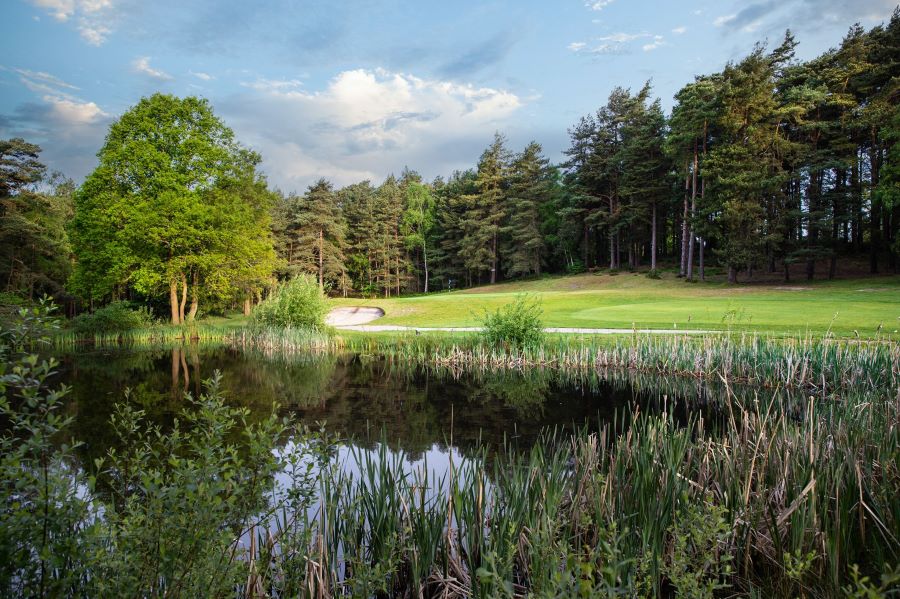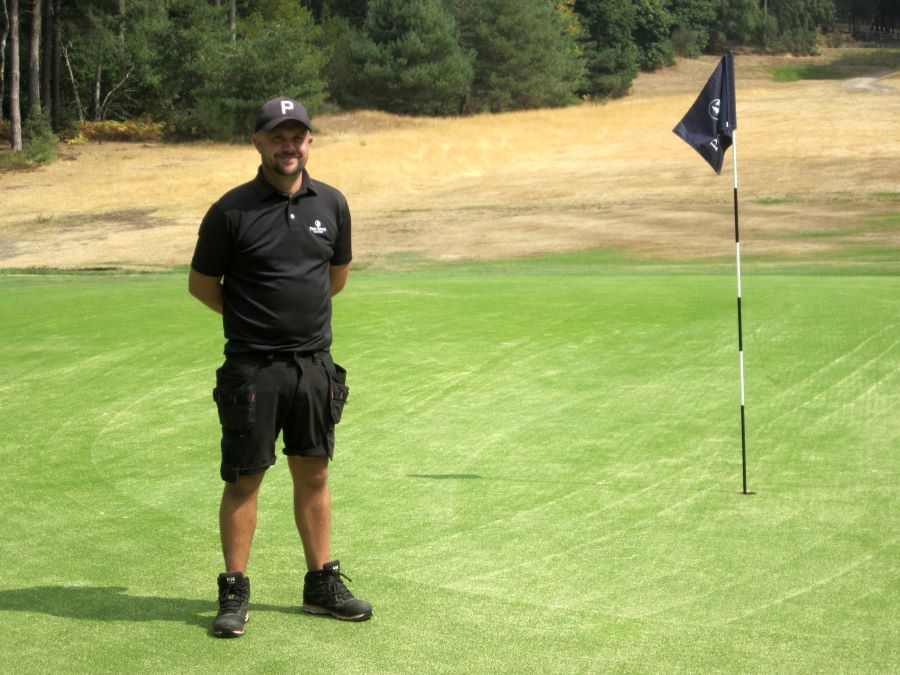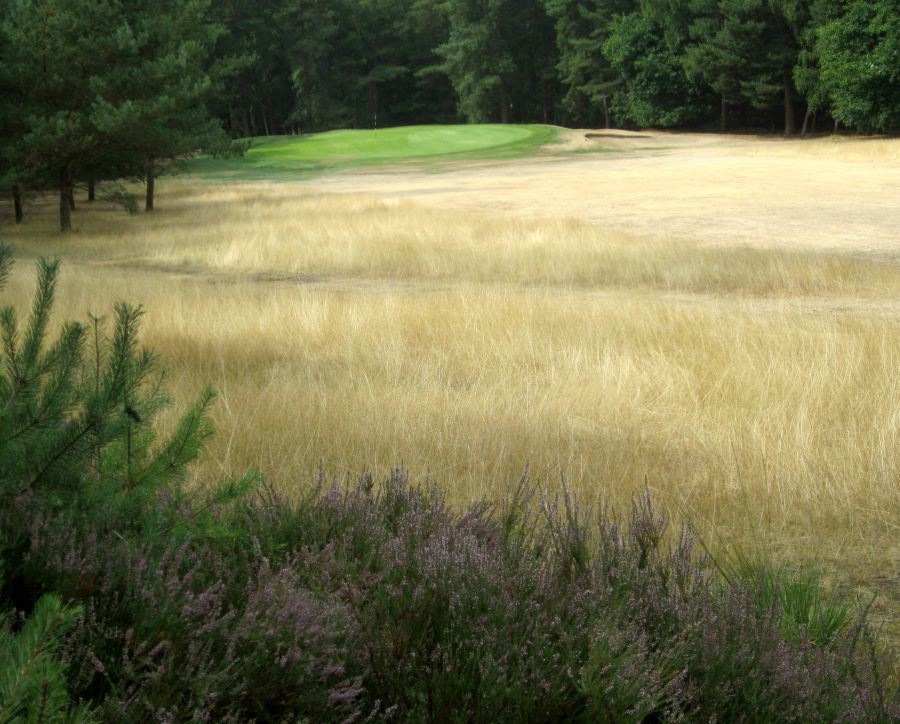- Homepage
- News and Features
- Pine Ridge - A Touch of Glass
Pine Ridge - A Touch of Glass
Pine Ridge in Surrey is a popular and busy daily fee golf course and Laurence Pithie MG met up with Course Manager Kevin Glazier to find out how he manages the site and how he prioritises work programmes while experiencing high levels of play.

Located in northwest Surrey, Pine Ridge is surrounded by numerous high quality golf courses, the majority of which are privately owned, including Sunningdale, Queenwood and The Berkshire.
The course was designed by local golfer and owner at the time, Clive Smith, and opened for play in 1993. This was at the peak of the last golf boom, but unlike the majority of its near neighbours, Pine Ridge was designed to target the daily fee golf market. Being of a higher standard and build quality than most other public or municipally run courses, the club’s aim has been to provide good quality at affordable cost, which proved to be a winning formula. After 14 years of private ownership, the club was sold to Crown Golf in 2007, which currently owns or operate seven other sites across the UK.
As its name suggests, this undulating golf course is largely located within pine woodland. The soil type is free draining, acidic sandy/loam of low fertility, mainly composed of dry heath and forestry. In other words, ideal for golf, so it is little wonder why this region to the southwest of London was favoured by the first golf course architects 130 years ago.

However, and like so many other golf courses, it is not without its challenges.
Course Manager Kevin Glazier began his career at Sherfield Oaks in 2005, before progressing to Royal Mid Surrey five years later. After a couple of years he was promoted to the deputy’s role on one of the two courses there under the guidance of Gavin Kinsella MG.
Kevin added: “I also served as support staff at Wembley for six years, which gave me a good insight into the different aspects of high level sports turf management.”
By the time he was appointed course manager at Pine Ridge in 2017, Kevin had gained his sports turf Level 2 and 3 qualifications along with a foundation degree in sports turf management at Myerscough College.
By the time he was appointed course manager at Pine Ridge in 2017, Kevin had gained his sports turf Level 2 and 3 qualifications along with a foundation degree in sports turf management at Myerscough College.
“I was also fortunate to attend the BIGGA Future Turf Managers Initiative in 2014,” said Kevin. “These experiences and qualifications gave me a sold background in which to progress my career.
“Being part of the wider group of Crown Golf courses and networking with other course managers, it was comforting to know that I wasn’t alone and that advice and support was there when required. This proved to be a benefit, especially during the early years of management, along with the help and encouragement from group courses manager, Mike Bush who is also a Master Greenkeeper. This proved invaluable.”

Unlike many courses located on heavier soils, Pine Ridge has superb natural drainage and aside from the odd low lying area where the flow of water is restricted, drainage is one issue the team doesn’t have to worry about. It is more the lack of water and a thin covering of soil that presents them with bigger challenges.
Kevin said: “This year’s drought and that of 2018, along with numerous days of temperatures in excess of 30°C, certainly challenges your ability in maintaining grass cover and producing acceptable playing surfaces. The fact we are tree lined on most holes is a limiting factor in regards to sunlight and air movement on and around greens and tees.
“Extended periods of leaf dampness increase disease pressure, while the trees compete with turf for both moisture and nutrients. Unfortunately, the trees are protected on this site and it can be difficult to gain permission for their removal. This means we have to manage the turf accordingly. Fortunately we have good sized teeing areas and only 36 bunkers of moderate size so I guess it’s a ‘swings and roundabouts’ scenario here at Pine Ridge.
“Golfers appear to see things favourably, however, and the playing conditions we provide are complimented on the various golf participation websites.”
Working practices
During our course walk, Kevin highlighted the methods used by his team and where his future priorities lie.
He said: “We focus on the greens, since this is what the golfers determine as the most important aspect of the game. We are blessed with a good golf course in a natural environment, but if we don’t have good greens then we fall short. To achieve our objective, we need to work smart and effectively as a team. This means understanding the environment in which the greens are located, the composition of the rootzone and the how the turf is best adapted to meet the requirements that the golfers and our company expect.
“Since around half the greens receive only limited sunlight, poa annua is the dominant species, growing on USGA spec rootzones containing 90% sand. Our objective is to maintain soil moisture content at around 25% and apply around 120kg of nitrogen per annum.” Throughout the main season, this is done via a foliar feed and growth retardant mix applied every fortnight.
Kevin added: “We have two maintenance weeks each year in February and August, in which we sand dress, deep and solid tine then brush. We are currently applying around 150 tons of Redhill sand each year.
“This year we have not cored, but we did scarify earlier and followed this up with regular verti-cutting throughout the season.”
Mowing and lightweight rolling is alternated, the former being at 3.75mm. Greens analysis indicates minimal organic matter, adequate root depth and the absence of black layer, thatch or dry patch.
“This programme provides the golfers with firm, smooth and consistent putting surfaces with a reasonable pace for the market we serve,” said Kevin.
Tee rootzones are similar to greens and as such can dry out fairly quickly. The team applies two granular feeds each year, supplemented with foliar feeds if necessary to ensure that adequate turf vigour is maintained. They are deep tined once and sand dressed and over-seeded with fine-leaved rye as often as required. Front approaches are foliar fed, while fairways and roughs are cut and brushed or raked accordingly.
Speaking in late August, Kevin said: “This year we have not cut any rough since June or fairways since early July, a sure sign of changing weather patterns that we have to adapt to. Both are predominantly fescue, since neither poa nor bent can survive the drought conditions we are faced with.

“Another interesting aspect regarding Pine Ridge is that we do not suffer from moles or rabbits, while any worm casting is limited to just a handful of tees and even then it’s only minimal. Insect damage is also negligible, although we have seen some evidence of bird pecking this year on a couple of greens.”
Moving forward
Other than maintenance practices, I asked Kevin what other work he and his team have completed recently and what his plans are over the next few years.
“It is irrigation first and foremost,” replied Kevin. “Our current system is 30 years old, most of which consists of PVC pipe with glued joints at six metre intervals. It has served us well, but sadly it has now reached the stage that almost every aspect is failing at some point.
“Water is our lifeblood on this sandy site and the there is only a thin covering of soil to hold any moisture. As a result, growth and recovery is slow.
“Combating wear is a challenge and one that we constantly have to address, hence the need for improved irrigation cover.
“Later this year, we will replace the tank, pumps and associated pipework and the following year it will be the rest of the system.”
Other work undertaken by the greenkeepers in recent years includes replacing old timber edging and sleepered steps on tees, general bunker renovations, path upgrades and woodland work.
Kevin said: “After the summer, we assess what turf renovations are required; namely what can be achieved via dressing and seeding, while prioritising areas for re-turfing this winter.
“Some minor re-landscaping of high wear, pinch-points are also likely in order to provide improved growth and drought tolerance.”
Another reason for Pine Ridge’s popularity is its floodlit practice range. Each of the 34 bays contains Top Tracer digital technology, which is linked to the 18 targets. This innovation is aimed at families as well as for those wishing to improve their skills and ball striking capabilities.
In summary
Around 40% of clubs within the UK are commercially managed, ranging from those at entry level in many towns and cities to those regarded as being exclusive. Pine Ridge is a modern daily fee facility and is rated highly in that category of golf courses. Having spent much of the day on the course with Kevin, it is clear that he and his team manage this site in a cost-effective manner, especially when compared with many of his illustrious neighbours. Working practices and programmes are targeted to provide golfers with a good and happy golfing experience, whereby they enjoy good playing surfaces within an attractive environment.
At a time when staff recruitment is possibly the greatest challenge for course managers, there have been no changes to the six-man team for at least three years. There is strong unity within the team, who have been pivotal in producing a good product.
Kevin is also fortunate to have Peter Brooker as his deputy, having served the club for well over a decade. This level of experience and team camaraderie is a great asset in the desire to produce the best possible conditions with the available resources on a course where close to 40,000 rounds are played annually.
There is a good range of equipment, which is regularly serviced in-house and is expected to last. Several front-line items, which are fully operational, have recorded at least 5,000 hours, which is testament to sound and effective management.
Kevin is on Twitter @kevinglazier17
Author

Laurence Pithie MG
The first turf professional to attain BIGGA’s Master Greenkeeper status in 1991, Laurence also won Greenkeeper and Groundsman of the Year in 1984 and 1988.
